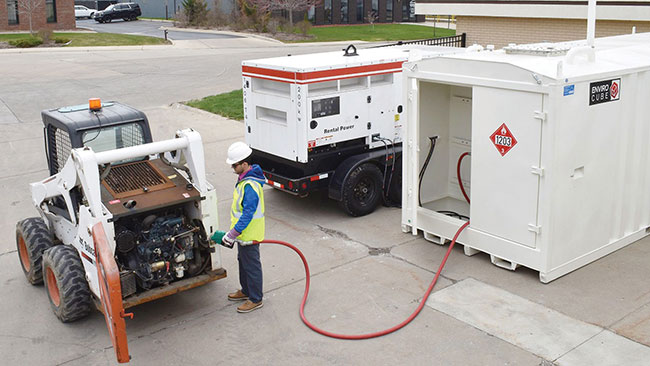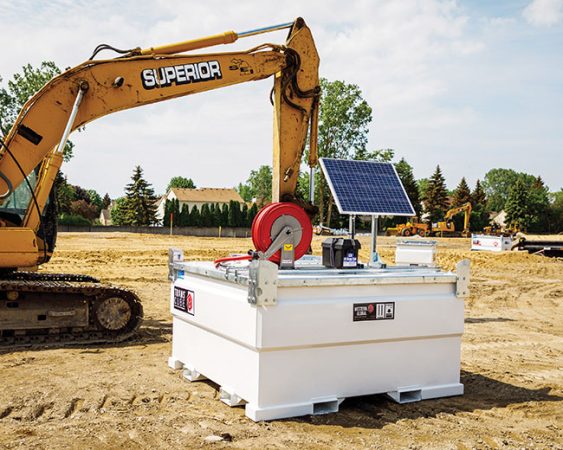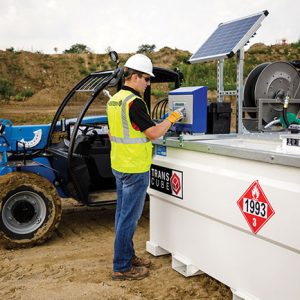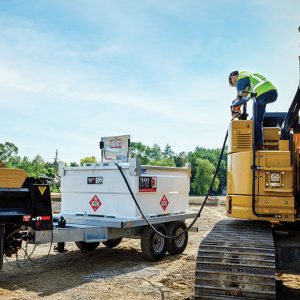
Selecting onsite fuel tanks
By Ken Steury
Features Tech tips construction diesel fuel gas transportTips for selecting the best modern fuel storage solution.
 Having an on-site solution for fuelling is being acknowledged more and more as a jobsite necessity.
Having an on-site solution for fuelling is being acknowledged more and more as a jobsite necessity. Some things change constantly. Take cars, for example. Each year brings significant changes and advancements and someday, fully autonomous cars will likely rule the road.
Fuel storage tanks, on the other hand, aren’t traditionally thought of as a rapidly changing product. However, more manufacturers are realizing the necessity of designing fuel storage solutions for the modern business, with features such as cloud-based remote fuel monitoring and global transportation approvals.
Diesel — the source of roughly 98 percent of energy consumed at the average jobsite — is a universal expense for operators. And, as the construction industry changes and companies become more competitive globally, profit margins will continue to shrink for businesses that don’t find new and efficient ways to manage assets, including fuel storage.
Today, on-site tanks can simplify fuel management for rental centres and their customers. To make the most of a fuel tank purchase, there are a number of factors to consider, such as the benefits of fuel monitoring, cleaning and maintenance costs, tank transportation, theft prevention and more.
Capacity and mobility
Determining the ideal solution starts with knowing how much fuel is being used and how mobile the fuel supply must be. After all, having an on-site fuel supply only saves time and money if it provides an adequate supply where and when it is needed.
Transportation options can range from certified lifting lugs for handling with a crane to DOT-approved trailers. The most easily transported options are smaller trailer mounted tanks typically holding between 200 and 1,000 gallons that are ideal for delivering fuel to remote sites. Some of the more important items to look for when buying a trailer-mounted tank include a sturdy trailer engineered to withstand the dynamic forces of the moving liquid while navigating rough, unpaved roads at jobsites. Tanks designed to comply with worldwide approvals, including UL, ULC, UN DOT and Transport Canada, are usually the most rugged and well-designed, as they are required to pass the rigorous testing and certification dictated by the various approval bodies.
Keep in mind, however, that just because a tank is approved, does not necessarily mean it’s the safest option. A lower centre of gravity, for example, will make the tank less susceptible to tipping during transport. And for full-fuel transport, internal baffle plates prevent fuel surging to keep the vehicle stable. In most locations, tanks without baffles must be emptied and often cleaned prior to transport, which can require a third-party environmental company.
If the job requires a larger tank of 1,000 gallons or more, consider how it will be moved around a jobsite. Round tanks often require a crane or loader to move. Most cube tanks can also be moved this way but, for added versatility, many also incorporate forklift pockets. Having more options can come in handy when equipment operators are busy or if certain equipment isn’t on the jobsite.

Mobility is a key consideration for fuel tanks on many sites. Look for designs with forklift pockets and lifting lugs.
Simplify compliance
Environmental regulations must also be considered and ground contamination is a major concern for on-site fuel tanks. While all tanks should meet basic environmental standards, round tanks — the traditional go-to storage option — come with the added expense of owning and cleaning secondary containment pans. The average bill for cleaning a containment pan is about $150, which can add up quickly in areas that require pans be cleaned on a regular basis or after it rains. An increasingly common feature on new tanks, particularly cube tanks, is double-walled 110-percent weatherproof containment. This eliminates the need for a secondary basin and can result in significant savings over the life of a tank.
Site-specific considerations
To meet the specific needs of different construction sites, it’s important to evaluate which features have the potential to increase value for a given operation. Tanks with multiple in- and out-ports, for example, allow the tank to serve as an auxiliary fuel supply while still being able to fuel trucks and other equipment. This can drastically extend runtimes for generators and light towers, as well as reduce the risk of running them dry.
For jobs at remote locations, the benefits of remote tracking technology can pay dividends. Remote fuel tracking helps operations monitor and manage supplies from anywhere via the cloud. For those with multiple projects at different sites, this can make it easy to stay on top of fuel supplies and know when a delivery is necessary.
Having tanks with secure access to fittings and dispensing equipment can also prevent unauthorized access and deter fuel theft. While many rely on regular padlocks, these are easy to cut and do little to deter thieves. Investing in more secure cabinets that position locks to be inaccessible to bolt cutters will better keep thieves at bay. While these security features will likely bump up the initial tank price, preventing a single theft of 50 gallons — roughly the capacity of a diesel pickup — may be enough to offset the difference.
Another location-specific consideration is the tank’s power supply. For mobile tanks and tanks at remote sites, adding options such as battery power storage and solar panels can help ensure that the tank will always have the necessary power to run the pumps. And for locations with space limitations, and for storage in rental yards, tanks that can be stacked help to free up space.
Fueling additional savings
No matter the tank or application, it’s important to buy from a trusted manufacturer. Reputable companies understand the importance of long-term customer satisfaction and are more likely to design tanks that are user friendly and will generate higher ROI over the life of the product. Built-in ladders, convenient manhole access doors and a solid warranty, for example, are strong indicators that a manufacturer is not cutting corners. Additionally, double-walled units with removable primary tanks make cleaning much easier. Over time, tanks that are easier to clean and maintain will likely last longer and yield a much higher return.
To extend the life of pumps, meters and other components, look for tanks with enclosed, weatherproof cabinets. This is a common feature on modern cube tanks and will greatly increase the longevity of components compared to tanks with components mounted on the top, where they are exposed to the elements. It is also worth checking whether your tank partner can supply the tank fully fitted with all the ancillary parts including pumps, placards and filters so that when the tank arrives at your site it is ready to rent as soon as it’s offloaded.
Additionally, choose a manufacturer that works closely with its customers to help select the ideal tank or fleet for the size and scope of the operation. Some manufacturers will even go as far as partnering with a customer to ensure all regulations, from local to state and from EPA to DOT, are met. By providing these services, manufacturers can save customers time and hassle.
As operators scramble to find new ways to decrease their operating expenses, fuel storage tanks — while not front of mind in terms of innovation and technology — should not be overlooked. And as regulations continue to change and the marketplace becomes more competitive, businesses should never ignore an opportunity to trim expenses and work more efficiently than the competition.
About the Author: Ken Steury leads Western Global’s regional sales team. He has over 20 years of industry experience and has been working closely with Western Global customers for nearly five years.
Print this page

